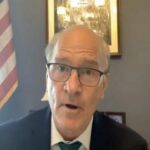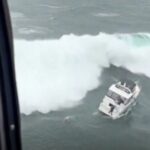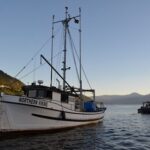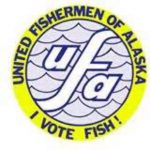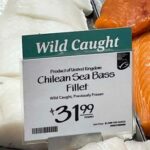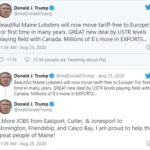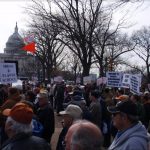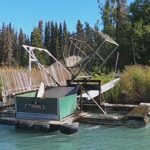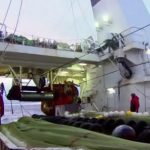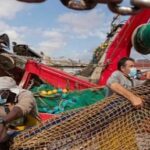Daily Archives: April 15, 2017
Helping US Shrimpers, New Trump order might hit India’s shrimp exports
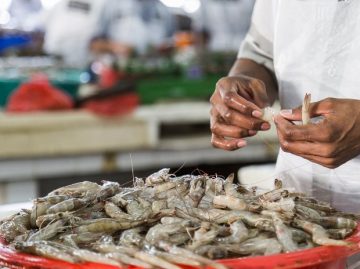 The $5.5-billion Indian seafood export market might face new restrictions in America. The new Donald Trump government, in an executive order, is set to enforce countervailing duties strictly on countries held to be dumping goods. America is the major importer of Indian seafood, with a share of 28.5 per cent in 2015-16, for 153,695 tonnes worth $1.3 billion. Frozen shrimp is the principal item of export to the US, with a share of 94 per cent in value terms. Another executive order directs their department of commerce and the Office of the US Trade representative to examine every form of trade abuse and non-reciprocal practice that contribute to the US’ large and persistent trade deficit, largest of any major nation in 2016 at $500 billion. Within 90 days, both these agencies are to give a comprehensive report to the President on the causes. “The US is the only country which is imposing an anti-dumping duty on Indian shrimp, to give level playing to its producers. click to continue reading the story 19:30
The $5.5-billion Indian seafood export market might face new restrictions in America. The new Donald Trump government, in an executive order, is set to enforce countervailing duties strictly on countries held to be dumping goods. America is the major importer of Indian seafood, with a share of 28.5 per cent in 2015-16, for 153,695 tonnes worth $1.3 billion. Frozen shrimp is the principal item of export to the US, with a share of 94 per cent in value terms. Another executive order directs their department of commerce and the Office of the US Trade representative to examine every form of trade abuse and non-reciprocal practice that contribute to the US’ large and persistent trade deficit, largest of any major nation in 2016 at $500 billion. Within 90 days, both these agencies are to give a comprehensive report to the President on the causes. “The US is the only country which is imposing an anti-dumping duty on Indian shrimp, to give level playing to its producers. click to continue reading the story 19:30
MAFMC Votes15-4 AGAINST Hudson Canyon Sanctuary bid
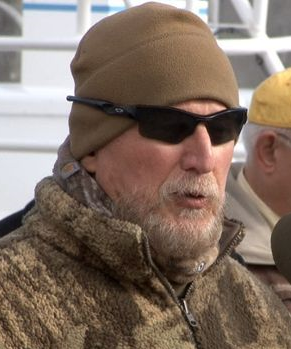 In their official nomination, the Wildlife Conservation Society (WCS) and their Coney Island Aquarium staff outlined their specific reasons for nominating the offshore Hudson Canyon as a National Marine Sanctuary. (We listened to the presentation online. It was pathetic, actually),,, While claiming to have “community-based support for the nomination expressed by a broad range of interests,” the WCS marine sanctuary plan had actual fishermen and fishing industry leaders incensed. In a letter of opposition on behalf of coastal fishermen, Recreational Fishing Alliance (RFA) executive director Jim Donofrio noted that regardless of the WCS’s intention, recreational fishermen would not have any legal protection under the federal sanctuary law. Thank you Jim. click here to read the story 12:54
In their official nomination, the Wildlife Conservation Society (WCS) and their Coney Island Aquarium staff outlined their specific reasons for nominating the offshore Hudson Canyon as a National Marine Sanctuary. (We listened to the presentation online. It was pathetic, actually),,, While claiming to have “community-based support for the nomination expressed by a broad range of interests,” the WCS marine sanctuary plan had actual fishermen and fishing industry leaders incensed. In a letter of opposition on behalf of coastal fishermen, Recreational Fishing Alliance (RFA) executive director Jim Donofrio noted that regardless of the WCS’s intention, recreational fishermen would not have any legal protection under the federal sanctuary law. Thank you Jim. click here to read the story 12:54
Canada has MPA Fever – Atlantic Canadian fishermen not hooked on idea
 A federal government plan to speed up the creation of more marine protected areas in Canada is getting pushback from some Atlantic Canadian fisheries groups. Marine protected areas are established to protect species at risk or unique species from human interference. These areas can close designated ocean and coastal areas to economic activities like offshore energy development and fishing. “This is a huge impact on all the fisheries in Canada,” said Ian MacPherson, the executive director of the Prince Edward Island Fishermen’s Association. MacPherson and other fishing industry representatives outlined their concerns this week in appearances before the parliamentary standing committee on fisheries and oceans. click here to continue reading the story 12:04
A federal government plan to speed up the creation of more marine protected areas in Canada is getting pushback from some Atlantic Canadian fisheries groups. Marine protected areas are established to protect species at risk or unique species from human interference. These areas can close designated ocean and coastal areas to economic activities like offshore energy development and fishing. “This is a huge impact on all the fisheries in Canada,” said Ian MacPherson, the executive director of the Prince Edward Island Fishermen’s Association. MacPherson and other fishing industry representatives outlined their concerns this week in appearances before the parliamentary standing committee on fisheries and oceans. click here to continue reading the story 12:04
Mystery shrouds the death of a Tarpon Springs fishing captain
 It began as a fishing trip like any other. Gregory Lasnier stocked the commercial fishing boat he captained with ice, bait and groceries. He waited for a deckhand who never showed. A friend hugged him goodbye. On Feb. 16, he set off alone, leaving his dock behind Holiday Seafood off Island Drive and steering the Daniel I into to the Gulf of Mexico as he had so many times before. It was a fishing trip like any other, until it wasn’t. The Coast Guard found Lasnier dead in the boat’s pilot house Feb. 26, on the other side of the Florida peninsula, hundreds of miles from any of his normal fishing spots. What happened on board the Daniel I during those 10 days remains a mystery. There is no body. There is no autopsy. There is no boat. Coast Guard responders said they couldn’t recover any of it. The boat was taking on water, and conditions were unsafe. They believe the Daniel I sunk off the coast of Sebastian Inlet south of Melbourne, although even that part of the story is unclear. But one thing is certain: The sea became his graveyard, the boat his casket. click here to read the story 11:29
It began as a fishing trip like any other. Gregory Lasnier stocked the commercial fishing boat he captained with ice, bait and groceries. He waited for a deckhand who never showed. A friend hugged him goodbye. On Feb. 16, he set off alone, leaving his dock behind Holiday Seafood off Island Drive and steering the Daniel I into to the Gulf of Mexico as he had so many times before. It was a fishing trip like any other, until it wasn’t. The Coast Guard found Lasnier dead in the boat’s pilot house Feb. 26, on the other side of the Florida peninsula, hundreds of miles from any of his normal fishing spots. What happened on board the Daniel I during those 10 days remains a mystery. There is no body. There is no autopsy. There is no boat. Coast Guard responders said they couldn’t recover any of it. The boat was taking on water, and conditions were unsafe. They believe the Daniel I sunk off the coast of Sebastian Inlet south of Melbourne, although even that part of the story is unclear. But one thing is certain: The sea became his graveyard, the boat his casket. click here to read the story 11:29
Telling it like it is! NOAA has done enough already and has failed in spectacular fashion
 One wonders why a Marine Sanctuary is needed to protect shipwrecks. Sanctuaries are usually established to protect ecosystems. The typical reason for establishing a Sanctuary off our shores is inapplicable because our native ecosystem has been destroyed. After the opening of the Saint Lawrence Seaway in 1959 NOAA was assigned the responsibility of protecting the Great Lakes from invasive species, essentially making the entire region a sanctuary. NOAA has failed in spectacular fashion.,, NOAA allowed the Lamprey Eel and Alewife into our native waters shortly after the Seaway opened. These and other foreigners decimated our native fishery. Smelt survived until the 1980’s but now they too have been displaced by some other invasive species that NOAA failed to protect us from, was it the Quagga Mussel or the Round Gobi? (must read) Click here to read the letter. 10:04
One wonders why a Marine Sanctuary is needed to protect shipwrecks. Sanctuaries are usually established to protect ecosystems. The typical reason for establishing a Sanctuary off our shores is inapplicable because our native ecosystem has been destroyed. After the opening of the Saint Lawrence Seaway in 1959 NOAA was assigned the responsibility of protecting the Great Lakes from invasive species, essentially making the entire region a sanctuary. NOAA has failed in spectacular fashion.,, NOAA allowed the Lamprey Eel and Alewife into our native waters shortly after the Seaway opened. These and other foreigners decimated our native fishery. Smelt survived until the 1980’s but now they too have been displaced by some other invasive species that NOAA failed to protect us from, was it the Quagga Mussel or the Round Gobi? (must read) Click here to read the letter. 10:04
Conecticut lobstermen fighting for survival
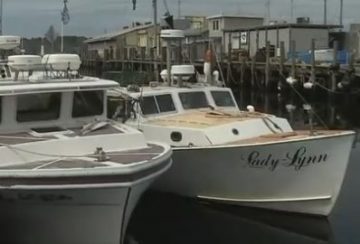 Connecticut’s Congressional Delegation wants to make sure that Connecticut Lobster Fishermen get their two cents in before they change any fishing plans for Southern New England. Lobster fishermen, fighting for survival, are being asked to speak up before federal regulators make a new lobster management plan for Southern New England. U.S. Sen. Chris Murphy and the Connecticut Congressional Delegation want the local lobster industry to survive long-term. But, lobstermen said new regulations could put them out of business at a time they see lobster catches growing. “Our records indicate it went up for the last three years not a lot, but a little bit,” Ted Whipple, who is a lobster buyer, said. Whipple said despite what government regulators claim, lobster fishing is improving. click here to read the story 08:49
Connecticut’s Congressional Delegation wants to make sure that Connecticut Lobster Fishermen get their two cents in before they change any fishing plans for Southern New England. Lobster fishermen, fighting for survival, are being asked to speak up before federal regulators make a new lobster management plan for Southern New England. U.S. Sen. Chris Murphy and the Connecticut Congressional Delegation want the local lobster industry to survive long-term. But, lobstermen said new regulations could put them out of business at a time they see lobster catches growing. “Our records indicate it went up for the last three years not a lot, but a little bit,” Ted Whipple, who is a lobster buyer, said. Whipple said despite what government regulators claim, lobster fishing is improving. click here to read the story 08:49


































